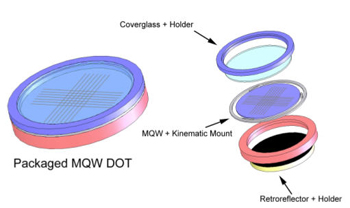DoD, Calit2 Fund $500,000 Investment in Advanced Chip Technology at UC San Diego
March 28, 2005 / By Doug Ramsey
MOCVD Reactor to Support Defense and Non-Military Research
San Diego, CA, March 28, 2005 -- The U.S. Department of Defense and the University of California, San Diego division of the California Institute for Telecommunications and Information Technology (Calit2) will jointly fund acquisition of a state-of-the-art system for depositing thin-film layers of materials, metals and oxides on tomorrow's semiconductors. The system will initially supply optical devices to a DoD-funded, small-business research project on 'optical tagging' - using optics to identify and track friends or enemies on the battlefield.
|
Under a grant from the Pentagon's Defense University Research Instrumentation Program (DURIP), the Army Research Office and Calit2 will split the $500,000 investment in a metal-organic chemical vapor deposition (MOCVD) system. MOCVD is a toxic but very effective method for depositing metal-organic 'glue' that binds together multiple layers of different materials to create advanced, compound microchips (so-called 'heterostructure' semiconductors).
"We are grateful to both the Department of Defense and Calit2 for investing in equipment that is normally out of reach for researchers on most university campuses," said principal investigator Paul Yu, chair of the Electrical and Computer Engineering department in UCSD's Jacobs School of Engineering. "It is essential to have a growth facility that can control the quality of the interface between different materials on advanced circuits, and the new system will give us that quality well into the future."
The MOCVD system will be housed in the materials-and-devices wing of Calit2's new headquarters on the UCSD campus in La Jolla, CA. Due for occupancy this summer, the new building will include 12,000 square feet of clean rooms for micro-to-nano fabrication, surrounded by facilities for materials growth and diagnosis. "We are dedicated to giving UCSD researchers access to world-class tools, and the DURIP grant will leverage the already considerable investment that Calit2 is making in its new clean-room facilities," said the institute's division director at UCSD, Ramesh Rao, who holds the QUALCOMM Endowed Chair in Telecommunications. "This investment is critical because over the next decade it will benefit many research projects which depend on the next generation of semiconductors to enable advances in optics, displays, wireless and other fields."
The MOCVD reactor will initially be used on a collaborative program among researchers from UCSD and Rancho Bernardo, CA-based Surface Optics Corporation to study multiple quantum well (MQW) modulators for optical tagging. The technology will be used in target tracking systems. UCSD will become a subcontractor of Surface Optics, and will supply MQW materials to an ongoing Small Business Technology Transfer (STTR) Phase II research project led by Surface Optics chief scientist Zuhan Gu, who holds a Ph.D. from UCSD. "The project is funded by the Army through the STTR program, which aims to increase small-business research in federal R&D," said Gu, a Visiting Research Scientist in UCSD's Electrical and Computer Engineering department. "STTR is also meant to promote collaboration between small business and large research institutions, and we look forward to a long and productive relationship with researchers at UCSD and Calit2 on this and future projects."
|
The MOCVD reactor will also provide materials for half a dozen ongoing research programs already supported at UCSD by DoD agencies. Those projects range from optoelectronic integrated circuits to nano-electronics, including advanced materials for devices such as quantum wells, quantum dots and quantum wires.
"There are many other future programs that will benefit from the MOCVD reactor, including materials and device studies for high-speed, high-power electronic as well as high-performance optoelectronic communication, sensing, and signal processing," added Yu, who noted that the MOCVD process offers exciting opportunities for the growth of semiconductor nanowires made of so-called III-V elements such as aluminum gallium arsenide. The MOCVD reactor will facilitate the integration of nanowires with other devices, and UCSD researchers are currently seeking DoD and NSF funding for further research in this area.
With its location in Calit2's multidisciplinary facility, the MOCVD reactor will support research in engineering, chemistry and other departments, and will also be available for use by Calit2-affiliated faculty from UC Irvine (UCSD's partner in the institute).
The MOCVD system has a reactor chamber designed for large-diameter wafer growth with the capability for device-quality epiwafers with thick MQW layers. The MOCVD tools are particularly well-suited for the critical first step in the growth of high-speed electronic, wireless and optoelectronic compound semiconductor materials employed in advanced wireless telecommunications and rapidly growing, high-brightness light-emitting diode (LED) lighting applications.
|
Because of the toxicity of the MOCVD process, the reactor will be located in a lab equipped with toxic gas scrubbing facilities, safety monitoring systems, and gas cabinets and gas switching systems. "In the new reactor, we also plan to install in situ monitoring systems, such as windows for photoluminescence and pyrometric measurements," said Yu. "As a result, we will be able to monitor the growth process over the entire wafer, and a fast switching and flow system will allow us to enhance the abruptness of the growth interfaces."
Professor Yu is the principal investigator on the project. Other investigators include Yu's fellow UCSD electrical and computer engineering professors Charles Tu, William S.C. Chang, and Deli Wang; Surface Optics' Zuhan Gu; as well as faculty from the Department of Chemistry and Biochemistry who are associated with Calit2, including professors John Crowell and Andrew Kummel. The DURIP grant will also provide materials and devices training to graduate and undergraduate students using the new facility.
The Army Research Office grant is one of 212 awards to 108 academic institutions receiving almost $44 million under DURIP, which supports the purchase of equipment that augments current university capabilities or develops new university capabilities to perform cutting-edge defense research. DURIP meets a critical need by enabling university researchers to purchase scientific equipment costing $50,000 or more to conduct DoD relevant research. The researchers generally have difficulty purchasing instruments costing that much under their research contracts and grants.
Related Links
Defense University Research Instrumentation Program (DURIP)
Surface Optics Corporation
Media Contacts Media Contacts:
Doug Ramsey, Calit2/UCSD, (858) 822-5825, dramsey@ucsd.edu
Jonathan Dummer, Surface Optics, (858) 675-7404, jdummer@surfaceoptics.com




